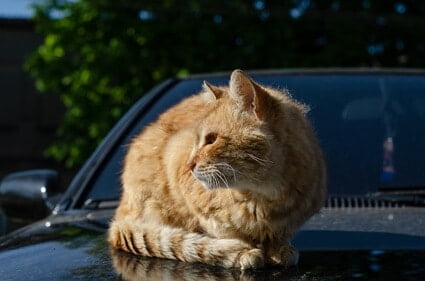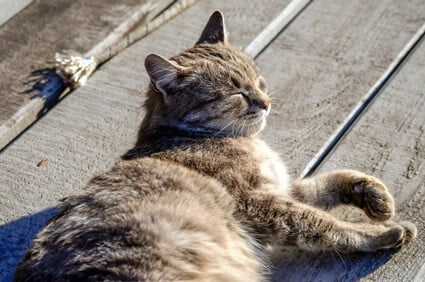In Cats Again Black Color Is Dominant to a Special Temperature
Sudden cat fur discoloration volition catch your attention. Y'all'll be used to your cat'south coat being a certain shade, so if it begins to undergo a variation in color, you may exist concerned that something is amiss with its health.
Some cats change color due to the temperature so, a cold cat could accept darker fur. Cats change color as they age, with younger cats condign darker and older cats turning gray. UV lord's day rays bleach dark fur. As well, sudden color changes can signify a hormonal imbalance or tyrosine deficiency.
Don't assume that sickness is why your cat'south fur is changing color. Familiarize yourself with the varied explanations, as some of them are inconsequential.
Why is My Cat's Fur Irresolute Colour?
Let'due south explore the dissimilar reasons why cats' fur colour changes:
Fever Glaze
Fever glaze is a status that impacts kittens, not adult cats.
It happens when the mother experiences stress or respiratory illness while pregnant. If this occurs, the litter will exist born with unique blueprint markings.
The kittens may take unusual fur shade combinations or a block color rarely associated with their breeds, such as silver or foam. This will be notable in breeds like the Siamese, which are commonly born with white fur.
Fever glaze isn't harmful to kittens and doesn't last long. After a few weeks, the glaze reaches its natural shade. From this point, it shouldn't change any farther.
Sunlight
Dark-haired humans notice that the sunday bleaches and lightens their hair. If your true cat is a lord's day-worshipper, its fur will change shade due to prolonged dominicus exposure. This is well-nigh noticeable in blackness cats, who will turn a rusty color.
This is due to melanin, which is plant organically in a cat's trunk. It's a genetic inheritance from a cat's parentage. Eumelanin provides blackness or night brown fur, while pheomelanin creates ruddy and orange shades.
Melanin isn't purely artful as it also protects a cat's delicate pare from being burned by the lord's day. Unfortunately, UV rays destroy melanin, causing a true cat's fur shade to lighten.
A cat's body is constantly replacing melanin, which ways its fur will eventually return to its normal shade. Usually, it'll demand to undergo a shedding cycle for this to happen.
A cat's fur lightening isn't a business, but it suggests that your cat is spending too much time in the sun.
Tyrosine Deficiency
A night true cat that steadily turns lighter may be experiencing a nutritional deficiency. Ordinarily, this relates to tyrosine, which is considered a non-essential amino acid because it's created within the feline trunk.
Cats need twice every bit much tyrosine as their bodies tin produce. According to the Journal of Small-scale Animal Exercise, the boilerplate true cat needs over 5g of tyrosine daily.
Tyrosine is related to melanin production, and a lack of it will bleach a true cat's fur. If your cat doesn't spend time in the sun, a tyrosine deficiency will probable explain the color change.
Tyrosine must feature in your cat's diet, merely any reputable, well-balanced true cat nutrient will contain this amino acid.
Vitiligo
Vitiligo is rare in felines, merely it can sometimes arise.
Vitiligo is a condition that causes the skin to lose pigmentation, resulting in white spots and patches around the cat'southward body. Any hair that surrounds this pare volition also lose coloring.
Focal vitiligo volition be concentrated on one part of your cat's skin, such as the nose leather. As cats have little hair in this area, the fur color is unlikely to be affected.
Generalized vitiligo will cause random, fiber-similar patches throughout the skin and fur. Vitiligo unremarkably starts small-scale and spreads. You'll find increasing changes to your cat'southward fur color over the months and years.
As explained past Experimental Biology and Medicine, vitiligo is an autoimmune disease. There'southward no cure for the condition, only information technology doesn't crusade any pain and discomfort.

Post-Surgery
If your cat has recently undergone surgery, its fur volition probable have been shaved to give the vet better admission to an expanse that requires medical attention. The aftermath of this is that you may find a modify in fur color.
Your true cat'south hormones react to the operation and anesthetic, leading to a temporary change in fur hue. Presently, your true cat will return to its normal fur color.
Your cat may be regrowing hair ahead of a shedding cycle. This volition be a unlike shade to what grows during the fall, but your cat's new coat will eventually catch up and match.
Skin Temperature
Some true cat breeds are genetically prone to fur colour changes, such every bit pointed breeds. This means that the cat's body temperature lowers equally its pare darkens.
This table summarizes cat breeds that regularly modify colour and the reason why it happens:
| Cat Breed | Reason for Fur Colour Change |
| Balinese: | Skin temperature |
| Birman: | Skin temperature |
| British Shorthair: | Skin temperature |
| Chinchilla: | Only outer, thicker fur is colored – different shades may appear after shedding. |
| Highlander: | Skin temperature |
| Himalayan: | Skin temperature |
| Javanese: | Skin temperature |
| Napoleon: | Peel temperature |
| Oriental: | Pare temperature |
| Western farsi: | Often born white, only transition into a wide assortment of colors |
| Peterbald: | Skin temperature |
| Ragdoll: | Skin temperature |
| Siamese: | Built-in white and darkens with historic period; fur color fluctuates depending on skin temperature. |
| Siberian: | Skin temperature |
| Tonkinese: | Skin temperature |
If your cat'southward brood isn't listed, at that place will be another explanation.
Fur Color Changes And What They Mean
Notation what color your cat'due south fur should be compared to the variation in hue:
Fur Turning Gray in Cats
Is your black cat turning white? If your cat is older than x, it'south natural as cats start to gray every bit they age considering the body produces less melanin as it grows older.
Grayness hairs will first appear around the cage and may spread from there. Gray fur is much more noticeable in darker-colored cats than lighter-colored cats.
Graying fur isn't a sign of imminent demise as cats alive longer as seniors than they do at any life stage. Gray fur can suggest that other ailments are likely to get a problem in the future, such every bit wobbly dorsum legs.
Blackness Fur Turning Brown in Cats
Black fur fading to brown is the get-go step toward eventual graying. A cat'south fur is unlikely to get directly from black to white, as there's a tedious fading process.
If your true cat seems besides young to exist going gray, bank check for other behaviors. If your true cat is acting out of sorts, it may have an organ problem, such as chronic renal failure.
Also, monitor how much fourth dimension your cat spends in the sun's UV rays.
Black Fur Turning Blood-red in Cats
Blackness fur turning a rusty shade of ruby has these explanations.
- Melanin product is slowing down with historic period
- Fur has been bleached in the dominicus
- Cat has a tyrosine deficiency
If your cat is growing older, this is natural and irreversible. If information technology's being bleached by the dominicus, the cat may be experiencing excessive UV exposure. A tyrosine deficiency tin be managed through diet or supplementation.
Brown Fur Turning Blackness in Cats
Chocolate-brown fur darkening to black is a symptom of excessive tyrosine.
Ensure that your cat is getting the correct quantities of this amino acid, as hitting the correct balance of vitamins and minerals is important to a true cat'southward health.
This alter can be due to excessive protein. As per Veterinary Clinics: Small Animal Practice, older cats even so demand protein, simply it needs to ingest the right corporeality.
Lite Fur Turning Chocolate-brown in Cats
Lighter-colored adult cats rarely get darker with any permanence. A cat with white or light brown fur will lack the appropriate pigmentation to darken sufficiently.
If your cat has pointed coloration, the fur darkens when the ambient temperature drops because the peel darkens.
Your cat may have stained its fur, specially if information technology roams outdoors. For example, your cat'southward fur could even be stained with feces from the litter tray.
Can a True cat's Fur Pattern Change?
A true cat'southward fur can change color, but its pattern won't modify. A spotted cat will always be spotted, and a stripy cat will ever accept stripes.
My True cat'southward Fur Changed Color Suddenly
If your cat's fur has changed colour seemingly overnight, at that place could be a medical explanation:
Stress and Physical Pain
Applied Animal Behavior Scientific discipline stated that stress could turn canine fur gray. However, it has never been proven that this also applies to cats, but it's possible.
Premature graying hair is linked to heightened levels of the hormone noradrenaline (norepinephrine). A cat'south torso constantly releases noradrenaline in pocket-sized doses, which is normal. Information technology differs from adrenaline (epinephrine).
Noradrenaline is connected to the nervous system and, during times of intense stress or pain, information technology floods the body. As per the Journal of Physiology, this occurs in felines, suggesting that the fur of a true cat in pain or stress can speedily plough gray.
Graying fur isn't necessarily a sign of stress or sick wellness, specially in older cats.
Look out for these warning signs:
- Hiding and reluctance to interact
- Excessive verbalization
- Uncharacteristic displays of assailment
- Restlessness
- Lethargy and depression
- Lack of interest in grooming or play

Hypothyroidism
Hypothyroidism is the issue of an underactive thyroid gland. This gland releases triiodothyronine (T3) and thyroxine (T4), which are essential for a true cat's torso and organs to function.
If the cat's thyroid gland is underactive, information technology won't receive enough T3 or T4, causing the following symptoms:
- Constant lethargy and exhaustion
- Weight proceeds
- Excessive thirst
- Depression body temperature (beneath 100 degrees Fahrenheit)
- Lack of training
- Lack of interest in play or activity
More pertinently, a hypothyroid cat will have a dull, listless coat.
Jaundice (Icterus)
Jaundice is a peel condition that will cause your true cat'due south skin to develop a yellow hue. This will be most noticeable in light-colored cats, where the fur will first to look dingy and discolored.
Jaundice is harder to spot in nighttime-furred cats. If your true cat's eyes are tedious and yellow and the gums are pale and faded, jaundice is a possibility.
Other common symptoms include:
- Loss of appetite
- Sudden weight loss
- Vomiting and diarrhea
- Chronic aridity
- Blood in the urine or carrion
- Lethargy and low
Cushing's Disease (Hyperadrenocorticism)
Cushing's illness will generate excessive cortisol (stress hormone). This disquiet differs from stress caused past generalized anxiety or physical pain, but the impact on fur can exist similar.
The symptoms of Cushing's illness include the following:
- Excessive thirst and urination
- Excessive hunger
- Shortness of breath
- Sluggishness and depression
- Bloated or distended abdomen
- Weak, damaged skin
The cause of Cushing's affliction will be a tumor, which will be located on the brain'southward pituitary gland. This is found on the base of the encephalon, and then an MRI will be required.
The tumor must be surgically removed. Molecular and Cellular Endocrinology describes this as a safety and effective treatment. In some cases, radiotherapy or chemotherapy may be required.
Cat fur changes colour all the time. This is a natural phenomenon in most instances, only health conditions can sometimes be responsible. If so, your cat'southward probable to show other physical symptoms.
Source: https://www.seniorcatwellness.com/cats-fur-changing-color/
0 Response to "In Cats Again Black Color Is Dominant to a Special Temperature"
Post a Comment